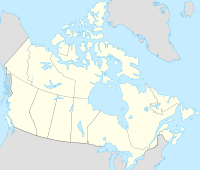Kashechewan First Nation facts for kids
Quick facts for kids
Kashechewan
|
|
|---|---|
| Kashechewan Indian Settlement | |
| Country | |
| Province | |
| District | Kenora |
| First Nation | Kashechewan |
| Official Website | https://www.kfncree.com/ |
| Population | |
| • Total | 2,537 |
Kashechewan First Nation is a First Nation community in Northern Ontario, Canada. It is home to the Cree people. The community is located near James Bay, on the northern side of the Albany River.
Kashechewan is one of two communities that started from Old Fort Albany in the 1950s. The other community is Fort Albany First Nation, which is on the southern side of the Albany River. Kashechewan is connected to other towns along James Bay by a special seasonal ice road or winter road. This road links it to Attawapiskat, Fort Albany, and Moosonee.
The community is kept safe by the Nishnawbe-Aski Police Service. This is a police service that focuses on Aboriginal communities.
When the community was first created, people chose the name "Keeshechewan." In the Cree language, this means "where the water flows fast." However, when the sign for the new post office arrived, it had a spelling mistake: "Kashechewan." This became the official name, but it doesn't have a meaning in Cree.
Contents
Life in Kashechewan
Schools and Learning
Kashechewan has two schools for its young people. St. Andrew's Elementary School teaches younger students. Francine J. Wesley Secondary School is for older students. These schools provide basic education for everyone in the community. The schools also have a council system that helps make decisions.
Health and Wellness
Kashechewan Health Services works to keep community members healthy. They offer programs that teach about important health topics like diabetes and cancer. They also help with pregnancy, parenting, and support during difficult times.
The Kashechewan Nursing Station provides basic medical care. It is run by Health Canada and works with the Weeneebayko Area Health Authority.
Shopping and Recreation
The Northern Store is the main place to buy food and other goods in town. It is the biggest building in Kashechewan. A helipad next to the store is used for medical transfers by Ornge. The store was recently updated and even has a Tim Hortons!
For fun and sports, there is the Kashechewan Community Arena. It's a great place for residents to play hockey. Outside the new Anglican church, there is a sports field. Here, people can play baseball, football, and soccer in the summer.
Community and Travel
St Paul's Anglican Church is the only religious center in Kashechewan. It is part of the Anglican Diocese of Moosonee.
The roads within Kashechewan do not connect to other towns. However, special winter roads are built to bring supplies to the community. Besides cars, skidoos are also a popular way to get around town.
To travel outside Kashechewan, people use the Kashechewan Airport or boats. Riverside Drive is the main road along the Albany River. There are also smaller side streets like Wa We Yas Ton Crescent. Most homes in Kashechewan are single-floor houses or trailer homes.
Water and Flood Control
A water treatment plant is located near the Albany River. There is also a dike along the river's north shore. This dike helps control floods, but Kashechewan can still experience flooding.
Plans are being discussed to build a permanent all-season road. This road would connect Kashechewan with Fort Albany, Moosonee, and Attawapiskat. It would also link these communities to the main provincial highway system. In 2021, a 311-kilometer James Bay Winter Ice Road was built. This road connects Attawapiskat, Kashechewan, Fort Albany, and Moosonee.
Water Quality Challenges
E. coli Discovery
In 2005, a serious problem with the water supply happened in Kashechewan. Over 800 people had to leave their homes. This was because E. coli bacteria were found in the water. E. coli is a type of germ that can make people very sick. The community had been under a boil-water advisory for two years before this. This means people had to boil their water before using it.
The problem was found to be a blocked chlorine injector at the water treatment plant. Local workers had not been fully trained to notice this issue. When officials fixed it, the water became safe again.
Before this, in 2001, a survey found many water problems in First Nation communities. Kashechewan was one of them. The report mentioned broken equipment, alarms not working, and a lack of trained staff.
Skin Conditions
Some community members believed the water was causing ongoing skin problems. In 2016, a politician named Charlie Angus shared pictures of children with skin issues. Doctors visited the community and found that many people, especially children, had skin conditions like scabies, impetigo, and eczema. These conditions were not considered a medical emergency. However, high chlorine levels in water can make skin dry, which can worsen itching and eczema.
Regular Flooding
Since 2006, Kashechewan has often faced flooding and water contamination. This happens when ice melts on the Albany River. Because of this, community members have had to be evacuated many times, especially between 2012 and 2019.
Community Relocation Plans
In 2006, a report suggested different ways to solve Kashechewan's ongoing challenges. These ideas included improving the current location or moving the community to a new, safer place.
In 2007, the Canadian government agreed to give Kashechewan First Nation $200 million. This money was for improving homes, buildings, and flood control in the existing community.
Then, in 2017, the governments of Canada and Ontario, along with Kashechewan First Nation, signed an important agreement. This agreement was about moving the First Nation community to a new location further up the river. Most people in the community had voted for this move. This decision is very important for the safety and quality of life for everyone in Kashechewan. Many leaders from the community and different levels of government were present for the signing of this agreement.




